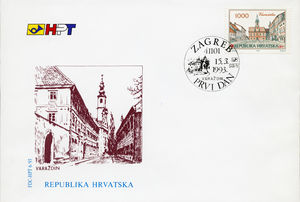First Day Cover: Varazdin (FDC) (Croatia 1993)
Varazdin (FDC) (Croatia 1993)
15 March (Croatia ) within release Croatian Towns (II) goes into circulation First Day Cover Varazdin (FDC) face value 1000 Croatian dinar
| First Day Cover Varazdin (FDC) in catalogues | |
|---|---|
| Croatian post Inc.: | Cro:HR FDC 6/1993 |
First Day Cover is square format.
Also in the issue Croatian Towns (II):
- Stamp - VARAŽDIN face value 1000;
- First Day Cover - Varazdin (FDC) face value 1000;
|
Data entry completed
50%
|
|
|---|---|
| First Day Cover Varazdin (FDC) in digits | |
| Country: | Croatia |
| Date: | 1993-03-15 |
| Emission: | Definitive |
| Format: | First Day Cover |
| Face Value: | 1000 Croatian dinar |
| Print run: | 7500 |
First Day Cover Varazdin (FDC) it reflects the thematic directions:
The City Halls are part of a market complex designed by John Carrick in 1882, but the grand hall itself was designed by George Murray and opened in 1841. It was the first hall suitable for large gatherings and concerts to be built in the City and played host to the likes of Benjamin Disraeli, Charles Dickens, Hungarian patriot Lajos Kossuth and William Ewart Gladstone. From its early days it hosted a wide variety of popular and classical concerts including those by touring groups such as Louis-Antoine Jullien's celebrated London-based orchestra and Charles Halle's orchestra from Manchester. Glasgow's first regular orchestral subscription concert series, played by an orchestra managed by the Glasgow Choral Union, was given in the grand hall from 1874 until the opening of the much larger St Andrew's Hall in 1877. Arthur Sullivan was its conductor for two seasons from 1875 to 1877. The Old Fruitmarket directly adjoins the grand hall and was a functioning market until the 1970s after which it was in occasional use for jazz and folk music events. The adjoining buildings were home to bustling produce markets such as the fresh fruit and flower market and the cheese market.
A building or edifice is a structure with a roof and walls standing more or less permanently in one place, such as a house or factory. Buildings come in a variety of sizes, shapes and functions, and have been adapted throughout history for a wide number of factors, from building materials available, to weather conditions, to land prices, ground conditions, specific uses and aesthetic reasons. Buildings serve several needs of society – primarily as shelter from weather, security, living space, privacy, to store belongings, and to comfortably live and work. A building as a shelter represents a physical division of the human habitat (a place of comfort and safety) and the outside (a place that at times may be harsh and harmful).
A town square (or public square, urban square, city square or simply square), also called a plaza or piazza, is an open public space commonly found in the heart of a traditional town or city, and which is used for community gatherings. Related concepts are the civic center, the market square and the village green.
In the visual arts, a cityscape (urban landscape) is an artistic representation, such as a painting, drawing, print or photograph, of the physical aspects of a city or urban area. It is the urban equivalent of a landscape. Townscape is roughly synonymous with cityscape, though it implies the same difference in urban size and density (and even modernity) implicit in the difference between the words city and town. In urban design the terms refer to the configuration of built forms and interstitial space.


